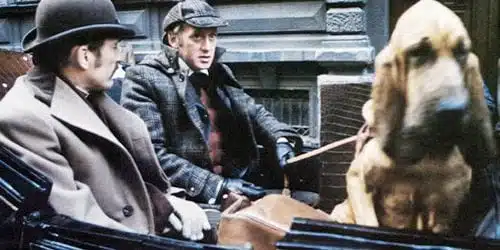
Arthur Conan Doyle wrote 56 stories and four novels featuring Sherlock Holmes, a fairly substantial body of work, but not nearly enough to satisfy the most ardent Sherlockians. Hence the steady stream of pastiches featuring Holmes, of which there are reportedly over 9,000 in existence.
One of the best-known of those pastiches is Nicholas Meyer’s 1974 novel The Seven-Per-Cent Solution, a best-seller adapted for the screen by Meyer and released as a film of the same name by Universal in 1976. Meyer’s central conceit is that the events related in the Conan Doyle stories “The Final Problem” and “The Empty House” never happened, not even in the fictional Sherlockian universe.
Very well, if Sherlock did not have a duel to the death with Dr. Moriarty at Reichenbach Falls, nor did he travel to Tibet to soak up some Eastern wisdom, what was he actually doing for all that time? In Meyer’s version, he was being treated by Sigmund Freud for his cocaine addiction, solving an international kidnapping case, and enjoying some time out of the public eye. While being treated by Freud, Holmes also recovers a repressed childhood memory that, in the spirit of all such recovered memories in fiction, goes a long way toward explaining why Sherlock is the way he is.
Meyer’s great inspiration was to have Freud and Holmes meet, but he doesn’t do much with it, at least not in this film. Instead, it’s merely a plot device to set off a series of set pieces strung out like laundry on the line, one following the next without much concern about either plot coherence or character development. Put it this way: if you’ve been harboring a secret desire to see Sigmund Freud play platform tennis, this is the film for you. By the time the final chase scene, which involves a train hijacking set to cartoonish music, rolled around, I was ready to heave my hardbound Complete Sherlock Holmes through the screen. Meyer received an Oscar nomination for the script, one of those inexplicable choices, like giving the Best Picture Oscar to Crash, that the Academy comes up with every now and then.
The most enjoyable aspect of The Seven-Per-Cent Solution is the painstaking recreation of period detail. They certainly put their money up on the screen with this one, in a style very much in keeping with other contemporary period films like Murder on the Orient Express and The Man Who Would Be King. Costume designer Alan Barrett was nominated for an Oscar for his work, and Ken Adam’s production design and Peter Lamont’s art direction are also noteworthy. The Seven-Per-Cent Solution includes a delightful Stephen Sondheim song, later known as “I Never Do Anything Twice”, which is sung, most appropriately, in a brothel.
Setting those pleasures aside, The Seven-Per-Cent Solution is enjoyable only in fits and starts. The acting is inconsistent to the point that it frequently takes you right out of the story. Robert Duvall does best with his understated performance as Watson, but Nicol Williamson chews up all the scenery with an extremely broad interpretation of Holmes. Alan Arkin’s accent and demeanor as Sigmund Freud owes more to the Borscht Belt than to turn-of-the-century Vienna, and he’s played as a remarkably incompetent physician as well, the better to let Holmes show off. Vanessa Redgrave is fine in a limited role as the kidnapped Lola Deveraux, Laurence Olivier has even less to do as Moriarty, and Jeremy Kemp can’t do much with his embarrassingly stereotypical role as the bigoted Baron Karl von Leinsdorf.
The Seven-Per-Cent Solution is loaded with references to the Conan Doyle stories that are sure to delight any ten-year-old reading them for the first time, as well as cultural references (Freud helpfully defines ennui for us, while Holmes informs us that the Lipizzaners are the smartest horses in the world) seeded throughout to give the film a vaguely educational feel. These features, plus the broadly comic accents (care for some “schhhhhtrudel?”) recall Neil Simon, a perhaps not surprising result since director/producer Herbert Ross directed a number of films written by Simon, including The Sunshine Boys, California Suite, and I Ought to Be in Pictures. Ross also directed several other glossy, middlebrow films that have a similar, audience-flattering feel, including The Turning Point and Nijinsky, and they haven’t aged particularly well either. But, looking on the bright side, if you enjoy those films, you’ll probably enjoy this one as well.
The bottom line on The Seven-Per-Cent Solution is that if you like your Sherlock Holmes pastiches glossy and toothless, you’re squarely in the target market this film. If, on the other hand, you prefer stories and films that at least try to capture the feel of Conan Doyle’s original stories, you’ll probably want to give it a miss.
The Seven-Per-Cent Solution comes in a slipcase with both a DVD and a Blu-Ray. Both discs contain the same material: the film and 25-minute video interview with Meyer in which he discusses writing the novel and adapting it for film.
